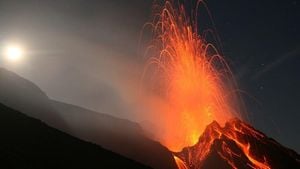Earth may have experienced its own rings, similar to those of Saturn, about 466 million years ago, according to groundbreaking research. This theory, which links the formation of potential rings around Earth to significant meteorite strikes during the Ordovician Period, opens up exciting avenues for exploring the planet's ancient climate and geological history.
Renowned for its spectacular ring system, Saturn stands out as one of the few planets boasting such celestial adornments. While many gaze toward Saturn with wonder, researchers are now turning their attention back to Earth to suggest it may not have been entirely ringless throughout its history.
During the Ordovician Period, Earth's life forms and climate were undergoing drastic changes. This time frame is characterized by significant geological and biological developments, including the gradual movement of tectonic plates and numerous variations within marine ecosystems. Remarkably, Earth also experienced a notable uptick in meteorite impacts, resulting in nearly two dozen impact craters concentrated within 30 degrees of the equator. According to the research published on September 12, 2023, in the journal Earth and Planetary Science Letters, this unusual clustering of meteorite strikes suggests they may have originated from debris created by the hypothesized rings.
Andrew Tomkins, lead author of the study and professor of Earth and planetary sciences at Monash University, explained, "It's statistically unusual to get 21 craters all relatively close to the equator. They should be randomly distributed if not caused by something specific. Yet, they aren't." This observation provides compelling evidence for the ring hypothesis.
But how could such rings have formed? Typically, celestial bodies are drawn together by gravity until they reach what is called the Roche limit—the point at which the gravitational forces become strong enough to break apart incoming objects. NASA’s research suggests this defines the distance at which smaller objects may be torn apart, enabling the formation of rings. It's believed this could explain the formation of Saturn's iconic rings, which likely emerged from the debris of its icy moons. Earth's hypothesized ring could have similarly arisen from the break-up of a significant asteroid.
Previous research had speculated about impacts of large asteroids creating meteorites, which might have led to the abundant strikes during the Ordovician. Tomkins and his team challenge this notion, proposing instead there was possibly one significant asteroid impacting Earth’s Roche limit at about 9,800 miles (15,800 kilometers) from the planet’s surface. The hypothesis suggests the asteroid, which could have reached about 7.5 miles (12 kilometers) in diameter, was already damaged by prior skirmishes with other celestial bodies. This would have left it exposed and easily fragmented by Earth’s gravitational forces.
Fascinatingly, the presence of this proposed ancient ring may also provide insights concerning one of the coldest events recorded in Earth's history: the Hirnantian Age. Following the surge of meteorite impacts, the planet experienced drastic global cooling. It’s theorized this chilling phenomenon could have been intensified by the shadow cast by the ring. Tomkins asserts, "If the ring existed, its shadow could have significantly influenced Earth's climate, leading to these dramatic changes."
The research team is currently pursuing additional studies to find out more about how long this possible ring might have existed and its impact on early evolutionary developments on Earth. The scientists are particularly interested to discover how the presence of such a ring and the resulting shadow might have shaped life on our planet.
Interestingly, the concept of rings isn't solely tied to Earth. Previous research has indicated Mars may have had rings as well, fueled by its moon, Phobos, potentially spiraling closer to the planet and facing fragmentation within the next 100 million years.
Reflecting on the sheer beauty and potential visibility of these rings, Tomkins muses, "It's difficult to visualize such rings without knowing the densities of the materials involved. Nonetheless, I can speculate even faint rings could have been breathtaking. If you were on the night side of Earth, with sunlight reflecting off these rings, it’d likely create quite the stunning backdrop."
To recap, the evidence suggests our planet engaged with significant dynamic processes millions of years ago, and these findings pose new questions about our history. How did Earth, much like its spectacular neighbors like Saturn, come to sport its own rings? And how did these celestial features influence not only the geology beneath our feet but the life forms above? Only additional research can provide clarity to the ancient mystery of Earth’s celestial love affair.



